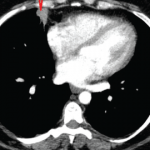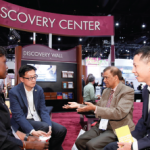In 2005, an ACR Workforce Study estimated the adult rheumatology workforce to be 4,946 providers and projected growth of only 1.2% by 2025, resulting in a projected deficit of 2,576 rheumatologists considering the estimated need. According to the 2015 Workforce Study, between 2005 and 2015, the percentage of internal medicine residents entering rheumatology has remained…
Search results for: fellowship training

5 Ways to Unlock the Power of Consultation
Think back to your time as a trainee. Do you remember an interaction with a consultant in which you learned something, felt your opinion was heard, were empowered to collaborate with the consulting team and knew you were providing outstanding care? We suspect a number of examples come to mind, regardless of the amount of…

The Diagnostic View: Our Findings
Click here for the case. Discussion Image 1 demonstrates two nodules in the right lung, one over the lateral costophrenic sulcus (2.4 x1.7 cm, not shown); and another in the middle lobe (3.1 x 2.6 cm), with lobulated and spiculated margins (red arrow). There was no lymphadenopathy or pleural effusion. Of note, a normal chest…

The ACR’s COIN Department Connects Providers with Communities
Last month I expressed my thoughts on the valuable and varied opportunities the ACR offers for professional and personal growth. Such engagement not only provides an opportunity to connect with your rheumatology colleagues, but also to have a positive impact on patients, supporters and all consumers of healthcare. ACR and ARHP members from every aspect…

How & Why Attending Physicians Should Teach in Patient Rooms
No matter where you practice, rheumatology clinics are extremely busy. And in that hustle and bustle we find an uncomfortable jostling of priorities between delivering optimal care for as many patients as possible and upholding education for teachers and learners at all levels. Because salary usually comes from seeing more and more patients, teaching is…

RISE Registry Helps ACR Members Successfully Navigate MIPS
Time certainly flies, and 2018 marks the second year that rheumatologists who see Medicare patients are operating under the new Quality Payment Program (QPP) created by the Medicare Access & CHIP Reauthorization Act (MACRA). MACRA repealed the Fee-for-Service model under the Sustainable Growth Rate (SGR) formula and transitioned Medicare reimbursement to a system more overtly…

Dr. Harry Spiera Retires after 60 Years in Rheumatology
When Harry Spiera, MD, stepped out of the New York University School of Medicine in 1958, rheumatology was in its infancy. Obviously, much has changed for both the physician and the specialty over the 58 years between then and his recent retirement. “Early on, rheumatology was the most clinical of the specialties, because the science…
Supply & Demand: Where Will the Rheumatology Workforce Be in 2030?
According to the “2015 American College of Rheumatology Workforce Study: Supply and Demand Projections of Adult Rheumatology Workforce, 2015–2030,” the demand for rheumatologic care is projected to exceed supply of clinical adult rheumatology providers by 4,133 clinical FTEs by 2030. The research now being published estimates the baseline adult rheumatology workforce, as well as determined demographic and geographic factors relevant to the workforce. The research also highlights the need for innovative regional strategies to manage future access to and reduce barriers to care for rheumatology patients in underserved regions…

Volunteer Roles in the ACR to Match Your Interest
Rheumatology is a small specialty, but the ACR has a large footprint in terms of activities and impact. The ACR’s remarkable success can be attributed to effective collaboration between a highly professional and talented staff and a large number of volunteer members. Under the direction of the Board of Directors, the activities and strategic initiatives…
Protect Your Patients’ Access to Care & Treatment
Persistent Challenges Sometimes the challenges seem neverending. In addition to the rigors of our daily lives as rheumatology health professionals—growing administrative burdens, increasing pressures to fund research and achieve balance in family and personal lives—we face a growing number of challenges related to the rapidly escalating prices of rheumatology treatments. Even more unfortunately, these costs…
- « Previous Page
- 1
- …
- 18
- 19
- 20
- 21
- 22
- …
- 67
- Next Page »